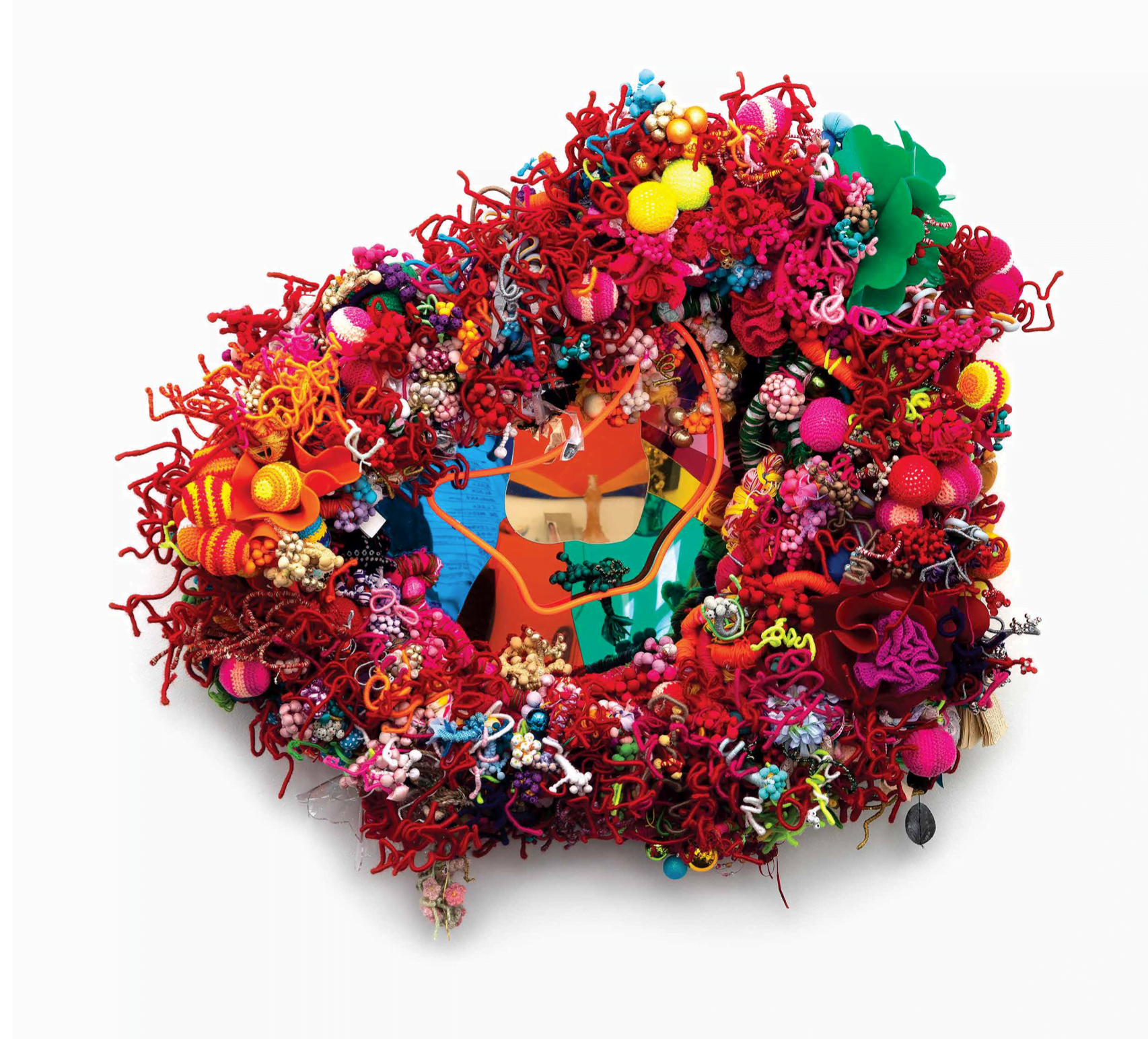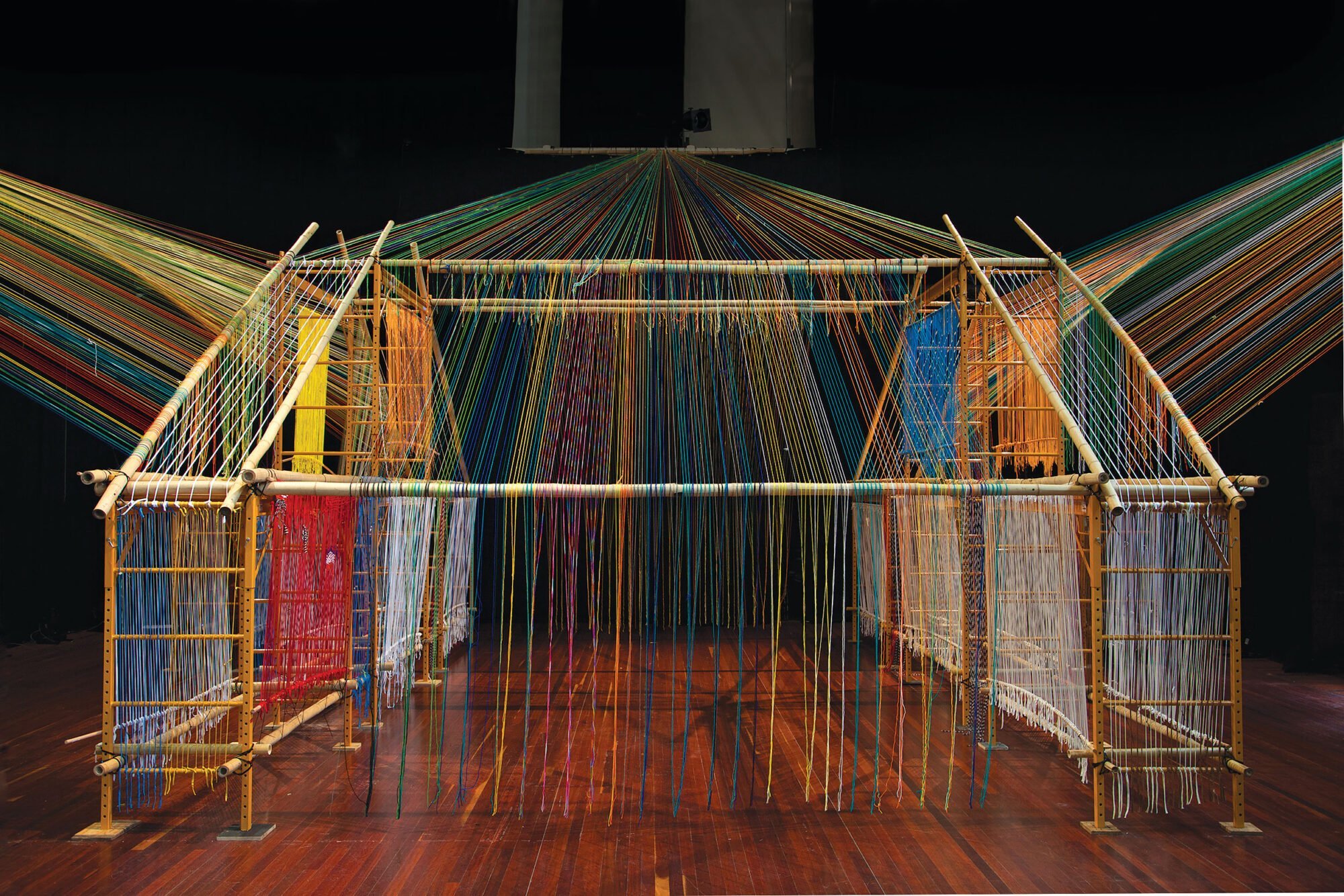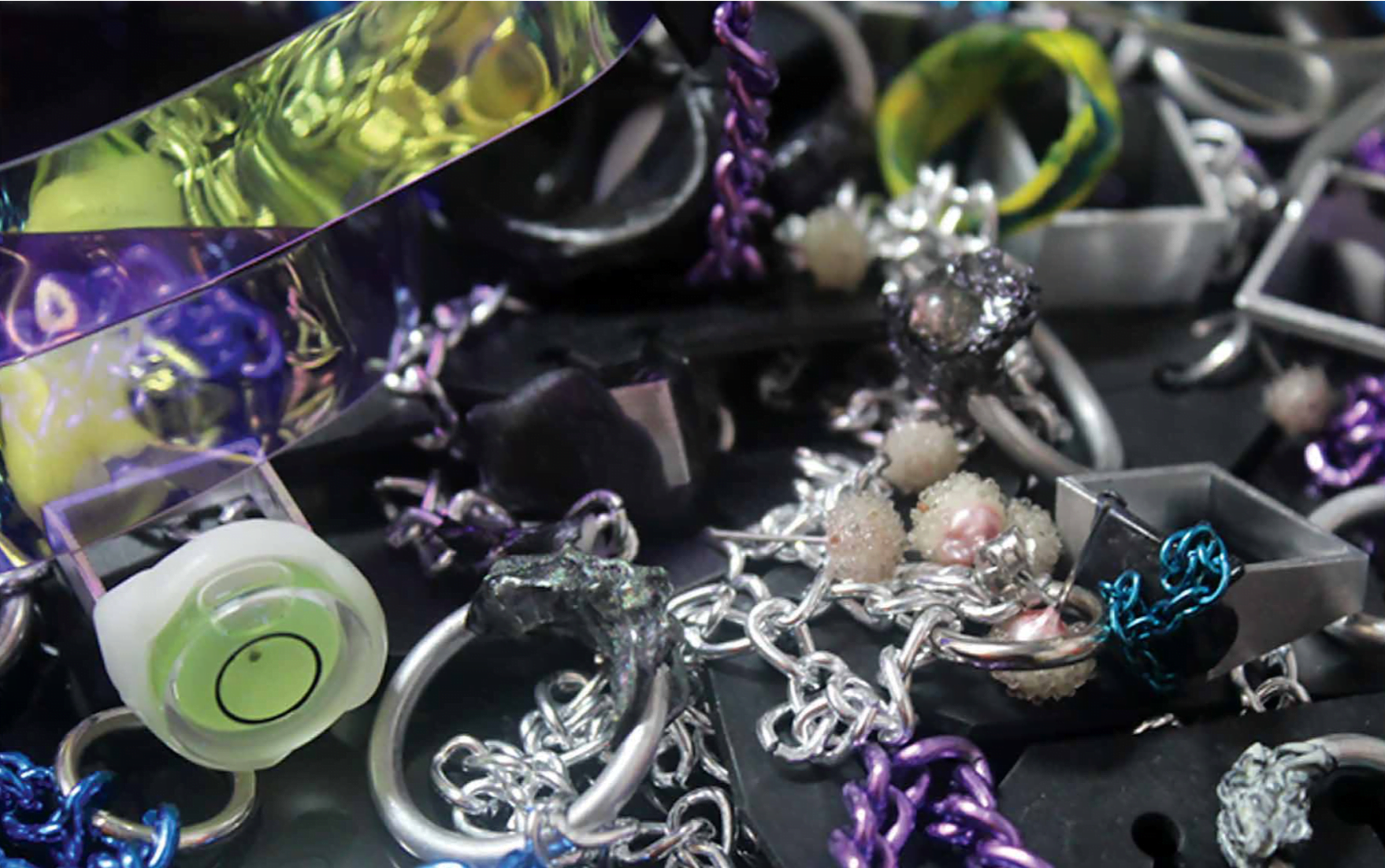The Social Spaces of Craft—
David Cross
Although there is a solitary dimension to crafting practices, whether it be in the pleasure of quiet knitting, or working in the studio with only the whirl of the sewing machine for company, craft has always at the same time been an avowedly social practice. Across the broad spectrum of crafts, from needlepoint and weaving to the bespoke production of jewellery, the activity of making is often not an end in itself, but an organisational structure around which generous and convivial social relations can be formed and nurtured. Indeed, of the myriad qualities of craft, one of the most alluring for practitioners is the way in which the manifold pleasures of making can be so easily elided with the energy generated through shared conversation. The intensely process-driven nature of craft means that a sudden explosion of laughter, or even furious disagreement within the craft circle/studio, does not necessarily jeopardise the object under construction. If anything, these moments seem to aid concentration and establish an important equilibrium between chance and repetition, focus and distraction.
Social relations play a fundamental role in the work of many artists in this exhibition; however, in the work of Catherine Bell, Hiromi Tango, Slow Art Collective and Debris Facility, they could be seen as a principal driver. For these artists, shared dialogue and collaborative processes are at the core of their assorted practices. Whether the social relations are generative, as in the case of Bell, or focused on shaping the form of the final work, as evident in the participatory collaborative projects of Slow Art Collective, they reflect the artists’ interrogation of artistic agency and, specifically, the value of ceding differing degrees of authorial ground to allow for other creative voices. In responding to the social turn in arts and crafts, these artists examine how an inclusive and collectivist approach across research and making allows for craft to push at the amorphous borders of what separates art from life.
Hiromi Tango is known for her often large-scale installations formed through assorted crafting processes. Formally rich and multi-layered, the works evoke a powerful dialogue between line, colour and space. Meshing two and three dimensions, her painstakingly assembled material forms combine the seemingly contradictory sensibilities of fragility and monumentality. Although Tango’s work has a highly distinctive syntax, she has also consistently sought to harness the contributions of a wide assortment of collaborators. Specifically, the artist is interested in the capacity of art and artmaking to heal, believing that through the unification of soul, spirit, mind, brain and body via creative action, it is possible to build a healthy and resilient human equilibrium. Her practice proposes participatory engagement in the arts not simply as a cultural good but as a means to address and dismantle trauma.

Hiromi Tango. Amygdala (Fireworks) 2016. © the artist, courtesy the artist and Sullivan+Strumpf, Sydney / Singapore.

Catherine Bell. Crematorium vessels 2012–13. © the artist, courtesy the artist and Sutton Gallery, Melbourne. Photo: Andrew Curtis.

Catherine Bell. Crematorium vessels 2012–13. © the artist, courtesy the artist and Sutton Gallery, Melbourne. Photo: Andrew Curtis.
Working with a wide diversity of groups and communities over the past ten years, Tango has developed a creative method that imbricates the pleasures of creativity with an increasingly in-depth engagement and knowledge of brain function from a medical and scientific perspective. In employing knowledge gleaned from working with medical scientists and experts on how the brain functions, the artist has tackled the complex territory of embedded trauma and, specifically, the potential for creative processes and experiences to aid participants in the understanding and healing of the psychological residue of past events. The work Amygdala (Fireworks) 2016, consisting of neon and mixed media, seeks to harness colour, assorted material forms and artificial light in order to activate what the artist describes as ‘primal emotions’. The amygdala is a part of the brain, the size of a dice, that is responsible for the fight-or-flight response. With this visually striking and complex work, Tango is asking us to confront our survival instincts and consider the instinctual yet highly damaging nature of fear. Amygdala (Fireworks) employs the logic of a vaccine (a small amount of visual trauma is required to build resilience to said trauma) and initially assaults the senses with its visual cacophony. This jarring effect then slowly shifts after a sustained engagement with the work, allowing the striking and even grating qualities of the sculpture to be experienced as a gentler illumination.
For Catherine Bell, social relations form a key arc in the research component of her artistic practice. The project Crematorium vessels 2012–13 developed out of a year-long artist residency at Caritas Christi Hospice, a campus of Melbourne’s St Vincent’s Hospital. Where previous residency artists utilised the hospice as a studio to make work, Bell saw greater potential in engaging directly with the staff, patients and their visiting families and friends, locating herself in the palliative day care unit. For two days each week, Bell facilitated a series of craft activities for patients with terminal illnesses. These sessions established a collective support structure and creative outlet for the patients, providing temporary, yet meaningfully affective, respite from the negotiation of mortality.
Bell was especially struck by the power and importance of flowers in the unit, both as a source of comfort and beauty for the patients, but also as a metaphoric reference to the fleeting bloom of life. Her sustained investigation of the culture and rituals associated with presenting, maintaining and subsequently replacing flowers led her to become fascinated with the cheap synthetic armatures that held the arrangements in shape and kept the stems moist. These structures are designed to prolong the life of the flowers, yet they cannot entirely neutralise the forces of entropy. In the same way modern medicine may slow the process of dying, these structures can only ever effect a modest extension of the flowers’ life cycle.

Bell’s activation of these found objects as sculpture speaks to their curious character as forms that are simultaneously almost indestructible and marked by a limited shelf life as flower revivers. Given to the artist every Wednesday of the residency by the indomitable Sister Mary, these plinths for flowers have been transformed from playing a supporting role into the main act. Having been placed covertly throughout the hospice for the duration of the residency, to collect the communal dust of bodies past and present, these Crematorium vessels now utilised as art objects evoke a singular charisma as markers of a space between life and death.
Where social relations activate a secondary process focused around Bell’s own object-based practice, the work of Slow Art Collective challenges ideas of authorship in relation to a finished object. Working at the intersection of craft and installation practice, Slow Art Collective is renowned for building elaborate architectural forms that are always definitively incomplete. These structures, employing a distinctive vocabulary of bamboo and coloured yarn, are always provisional in the sense that, throughout the life of the works, audiences are given agency to shape and form them with their own creative sensibility. The works are never finished or resolved but, instead, time out at the end of each showing – left as markers of often hundreds of small performative modifications.
The collective is highly adept at calibrating a balance between its own bespoke artistic language and the myriad contributions of the audience, who are encouraged to become participants, indeed collaborators, in the work. Such an approach marries a relational or horizontal understanding of the power relations that straddle objects, institutional space, authorship and participation. In seeking to work against the idea of heroic objects produced by a small clique of profoundly gifted artists, Slow Art Collective offers a mode of creativity that is inclusive and predicated on generosity and free expression.
Key to this approach is the deliberate manipulation of time in relation to how the work is experienced. Drawing on the global slow food movement, which highlights the importance and value of taking time to produce, assemble and consume food, Slow Art Collective applies this logic to the experiencing of art. By encouraging audience participation in the crafting process, the artists establish the potential for a languid encounter, for getting lost in the joys of self-expression. In so doing, they markedly extend the median time audience members are prepared to commit when encountering artworks, thus creating the preconditions for affective experiences that are able to seep in over an extended duration.
In responding to the social turn in arts and crafts, these artists examine how
an inclusive and collectivist approach across research and making allows for
craft to push at the amorphous borders of what separates art from life.
Like Slow Art Collective, Debris Facility Pty Ltd (or Debris Facility) is an artistic collective that prefaces the primacy of creative output over the cachet, or cult of personality, associated with individual artists. Yet where Slow Art Collective consciously offers a critique of the hyper-speeds of contemporary life, Debris Facility goes undercover, so to speak, in seemingly adopting the gormless language and production methods of 21st century globalised corporations. Neither their name nor their artistic output indicates a craft collective so much as a nebulous corporate enterprise that could be a small armaments supplier in Eastern Europe or an accountancy firm offering advanced tax evasion services in Bermuda. In mimicking the seemingly anonymous, rhizomatic qualities of contemporary commodity production, Debris Facility offers an acerbic critique of an economic system designed for maximum profit and minimal accountability.
Debris Facility’s approach to craft is to highlight the ways in which the charisma and cultural value of bespoke objects, such as jewellery, are placed under threat from a nascent system that seeks to apportion value solely through the prism of dollars. The project for Craftivism. Dissident Objects and Subversive Forms entitled Production Displacement 2018–20, is a site-specific installation in Shepparton Art Museum (SAM)’s Showcase cabinet that slyly replicates this system of commodification while at the same time offering a pointed riposte. The work features precisely 303 seemingly mass-produced jewellery items, each carefully presented in a custom-made, almost corporate, display system. Each day, one item will be chosen from the display by a SAM staff member and added to the SAM Collection via the donation box. So as to confuse the status of these objects as precious museum artefacts, they are also sold in the SAM shop, with the museum taking on the unfamiliar role of commercial gallery dealer.1
In keeping with the interrogation of not just the value of the jewellery but the entire system of production, Debris Facility will also include in the exhibition some of the correspondence and contractual documentation that has been generated in its discussions with SAM. For the collective, these negotiated settlements are not incidental, but fundamental to the meaning of the work as they provide an insight into the power dynamics and bargaining strategies that increasingly underlie the artist–museum relationship. They highlight that the meaning and value of artworks need to be understood not simply in the end products – the works themselves – but in the entire system that allows for these forms to be produced, displayed and distributed.
Debris Facility takes us on a journey that reveals how, today, an artistic object is not simply made in a studio or production facility, but within a complex web of mechanisms, exchanges, transactions and display systems. For Debris Facility, as well as for Catherine Bell, Hiromi Tango and Slow Art Collective, the art object’s charisma is never simply the result of magic produced in the studio, but is incrementally value-added or accrued over time. Indeed, only after a stunning array of processes and social relations are successfully negotiated and the forces of entropy, fickle taste and the potentially debasing effect of the gallery gift shop neutralised, can the art object attain what we might describe as a heightened degree of relevance and value. In assorted ways, these artists highlight the continued efficacy of the object as a powerful mechanism that speaks to and challenges the conditions under which we currently live. But each of them offers the important caveat that without a profound negotiation of social relations, the art object is always at risk of ossification and co-option.
1. While the project will begin its life as a site-specific installation at SAM, for the NETS Victoria tour, the residue of this process will be exhibited in a custom-made donation box that emulates the scale of the one at SAM. This will be shown alongside some of the framed documentation and contractual information.

Debris Facility Pty Ltd. Production Displacement 2018–20. Shepparton Art Museum Collection. © Debris Facility Pty Ltd.
